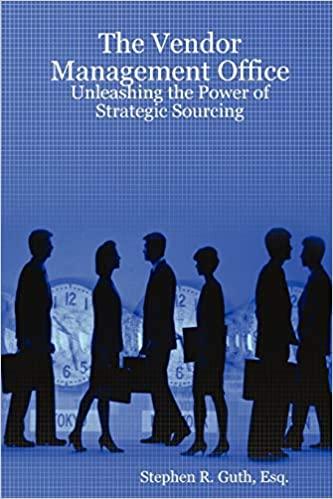Answered step by step
Verified Expert Solution
Question
1 Approved Answer
The SweetTooth Candy Company knows it will need 10 tons of sugar 6 months from now to implement its production plans. Jean Dobson, SweetTooth's purchasing
The SweetTooth Candy Company knows it will need 10 tons of sugar 6 months from now to implement its production plans. Jean Dobson, SweetTooth's purchasing manager, has essentially two options for acquiring the needed sugar. She can either buy the sugar at the going market price when she needs it, 6 months from now, or she can buy a futures contract now. The contract guarantees delivery of the sugar in 6 months but the cost of purchasing it will be based on today's market price. Assume that possible sugar futures contracts available for purchase are for 5 tons or 10 tons only. No futures contracts can be purchased or sold in the intervening months. Thus, SweetTooth's possible decisions are: (1) purchase a futures contract for 10 tons of sugar now, (2) purchase a futures contract for 5 tons of sugar now and purchase 5 tons of sugar in 6 months, or (3) purchase all 10 tons of needed sugar in 6 months. The price of sugar bought now for delivery in 6 months is $0.0851 per pound. The transaction costs for 5-ton and 10-ton futures contracts are $65 and $110, respectively. Finally, Ms. Dobson has assessed the probability distribution for the possible prices of sugar 6 months from now (in dollars per pound). Table 10.5 contains these possible prices and their corresponding probabilities. a. Given that SweetTooth wants to acquire the needed sugar in the least-cost way, formulate a payoff table that specifies the cost (in dollars) associated with each possible decision and possible sugar price in the future. b. Use the PrecisionTree add-in to identify the strategy that minimizes SweetTooth's expected cost of meeting its sugar demand. Also, perform sensitivity analysis on the optimal decision and TABLE 10.5 Distribution of Possible Sugar Prices Possible Sugar Prices in 6 Months ($/pound) Probability 0.078 0.05 0.083 0.25 1- 0.087 0.35 0.091 0.20 0.096 0.15 summarize your findings. In response to which model inputs is the expected cost value more sensitive? c. Generate a risk profile for SweetTooth's optimal decision. 2- Each day the manager of a local bookstore must decide how many copies of the community newspaper to order for sale in her shop. She must pay the newspaper's publisher $0.40 for each copy and sells the newspapers to local residents for $0.50 each. Newspapers that are unsold at the end of day are considered worthless. The probability distribution of the number of copies of the newspaper purchased daily at her shop is provided in Table 10.14. Employ a decision tree to find the bookstore manager's profit-maximizing daily order quantity. TABLE 10.14 Distribution of Daily Local Newspaper Demand Daily Demand for Local Newspaper Probability 10 11 12 13 14 0.10 0.15 0.30 0.20 0.15 B60.2350 2 Prof. Juran 3-The Westhouser Paper Company in the state of Washington currently has an option to purchase a piece of land with good timber forest on it. It is now May 1, and the current price of the land is $2.2 million. Westhouser does not actually need the timber from this land until the beginning of July, but its top executives fear that another company might buy the land between now and the beginning of July. They assess that there is 1 chance out of 20 that a competitor will buy the land during May. If this does not occur, they assess that there is 1 chance out of 10 that the competitor will buy the land during June. If Westhouser does not take advantage of its current option, it can attempt to buy the land at the beginning of June or the beginning of July, provided that it is still available. Westhouser's incentive for delaying the purchase is that its financial experts believe there is a good chance that the price of the land will fall significantly in one or both of the next two months. They assess the possible price decreases and their probabilities in Tables 1 and 2. Table 1 shows the probabilities of the possible price decreases during May. Table 2 shows the conditional probabilities of the possible price decreases in June, given the price decrease in May. For example, if the price decrease in May is $60,000, then the possible price decreases in June are $0, $30,000, and $60,000 with respective probabilities 0.6, 0.2, and 0.2. If Westhouser purchases the land, it believes that it can gross $3 million. (This does not count the cost of purchasing the land.) But if it does not purchase the land, it believes that it can make $650,000 from alternative investments. What should the company do? B60.2350 3 Prof. Juran Price Probability Decrease $0 0.5 $60,000 0.3 $120,000 0.2 Table 1: Distribution of Price Decrease in May Price Decrease in May $0 $60,000 June Probability June Probability Decrease Decrease $0 0.3 $0 0.6 $60,000 0.6 $30,000 0.2 $120,000 0.1 $60,000 0.2 Table 2: Distribution of Price Decrease in June B60.2350 4 $120,000 June Probability Decrease $0 0.7 $20,000 0.2 $40,000 0.1 Prof. Juran
Step by Step Solution
There are 3 Steps involved in it
Step: 1

Get Instant Access to Expert-Tailored Solutions
See step-by-step solutions with expert insights and AI powered tools for academic success
Step: 2

Step: 3

Ace Your Homework with AI
Get the answers you need in no time with our AI-driven, step-by-step assistance
Get Started


